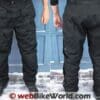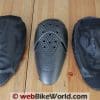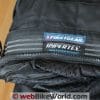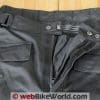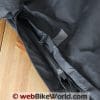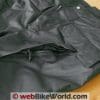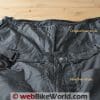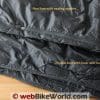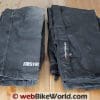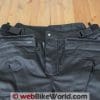If you want what is arguably one of the best heavy duty textile outer garments on the market, then these pants, albeit slightly flawed, are the solution.
Firstgear continues to offer a wide size range for the HT and other product lines, one reason why their products may be in such high demand.
Find your size, put them on and enjoy them for many years and many miles.
After almost eight years of sustained use, my current early-edition pair of Firstgear HT Overpants (HT = Hypertex) is showing some wear and tear.
Continued exposure to sun, rain, sleet, snow and mud, along with some ground exposure (abrasion) and whatever else I have gotten up to or into is now more evident than ever.
This wear, with some minor tear, is a tribute to their quality and durability.
Outside of the front fly zipper pull having gone missing about two years ago and then another metal pull breaking off the right leg zipper last year, nothing else has broken or failed to perform.
The pants remain virtually weatherproof, even with a few tear spots.
Did I say these Firstgear HT over-pants are the best riding pants I have ever owned? But, as they say, “there comes a time”.
And with temperatures heading down towards the freezing point (32C/0C) earlier this fall, I had to accept that it was indeed time to finally augment the riding gear collection by adding another pair of pants that could address my three- to four-season riding requirements.
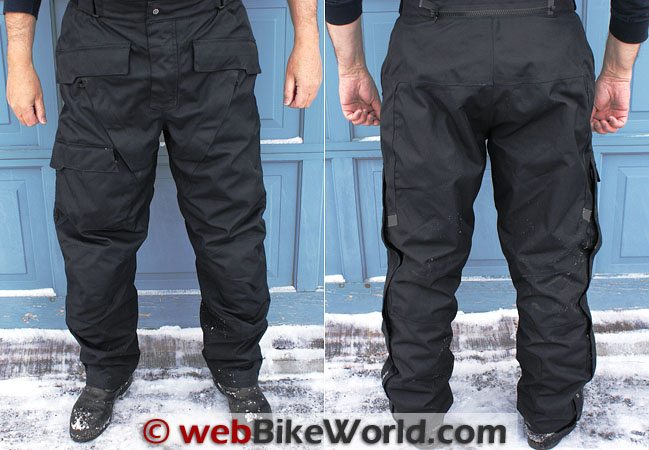
Background
Not that I haven’t been looking…
But after close to a year of trying on numerous pairs of pants from various manufacturers and dealing with 34-inch inseam requirements, I had only managed to find one other pant that fit relatively well.
That was a discounted pair of the BMW Rallye 2 pants, that coincidentally matched my Rallye 2 jacket.
As much as I like the BMW Rallye products, such as the BMW Rallye 3 jacket and pants (review), for my climate the jacket and pants are best suited for late spring through early fall, unless an under-layer (i.e., heated clothing) is utilized.
Accordingly, further rationalization dictated that just getting another pair of the HT Overpants was the best option.
But, there were two issues to address.
First, as a premium textile product, the Firstgear HT Overpants are more expensive north of the border, thanks in part to a continuing heavy tax on textile products.
And secondly, nobody had a size 38T in stock — not unexpected given the time of year.
Online sourcing loomed, with all that implied.
In corresponding with the Editor about some of the other Firstgear clothing reviews done recently, I commented on the fact that the original product lines didn’t seem to get much attention, despite their reputation, strong performance and continued availability.
Another factor was the fact that the HT Overpants were redesigned for 2011, providing the perfect opportunity to do a long overdue review of both the old and the new.
The timing was right as well and a day after arriving in Florida for two weeks of riding and relaxation, a pair of the new Firstgear HT Overpants in 38T came in the mail — new, still on the hanger and very welcome.
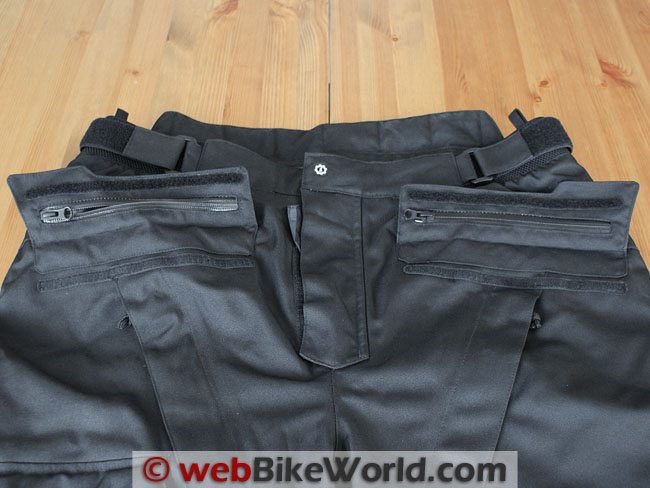
Firstgear HT Overpants – Old vs. New
Before getting into some of the nitty-gritty points regarding the old and the new versions of the Firstgear HT Overpants, it is worth taking a look at what the redesigned product offers up for features.
The New-for-2011 Features Include:
- Removable zip-out liner pant that can be worn as a stand-alone casual pant.
- The overpant is sized to fit over clothing (just buy the size you normally wear).
- Strong 600 Denier Hypertex Waterproof/Breathable polyester outer shell.
- Adjustable and removable CE-approved armour used in the knee pads.
- Adjustable and removable EVA soft foam hip protectors.
- Ergonomic design with articulated knee and seat areas provide maximum riding comfort.
- Two front thigh air intake vents (slash style) provide increased air flow when needed.
- Two front overflap with zipper pass-through pocket openings provide access to liner pockets.
- Large right-thigh cargo pocket with overflap · Side zippers are 2/3 length for easy on/off of overpants, double storm flap seals out elements.
- Lower leg inside storm cuff with elasticized silicone grip band keeps elements from intruding.
- Double closure waist with custom fitting provided by adjustable side tabs.
- Inner calf area uses heat-resistant material.
- Ten (10) inch conjunction zipper allows interconnection with compatible jackets.
- Tall sizes feature 34.5 inch inseam (per posted sizing chart).
- Two year limited warranty.
One major difference is that the inner thermal liner now functions as a standalone pant. This feature has become a standard for many manufacturers and it is good to see Firstgear also providing this capability.
The ability to use the inner liner on and off the motorcycle provides versatility, something appreciated especially when packing space is limited.
The Firstgear HT inner pant is made of water-resistant taffeta with 2/3 length side zippers, adjustable side tabs allow custom fitting like the overpants. Functional belt loops are stitched around the waist.
As with the overpant, the liner pant ergonomically designed with articulated knee and seat sections for comfort.
A two (2) ounce fibrefill layer provides warmth and additional comfort when wearing the pants. An almost-full circumference waist zipper and simple leg snaps, two per leg, secure the liner pants to the overpant.
The high-cut waist and additional hi-cut back provide a very comfortable fit on and off the motorcycle.
The extra height at the back serves to provide a bit of lower back support and additional protection from the elements, especially once an upper outer garment is put on.
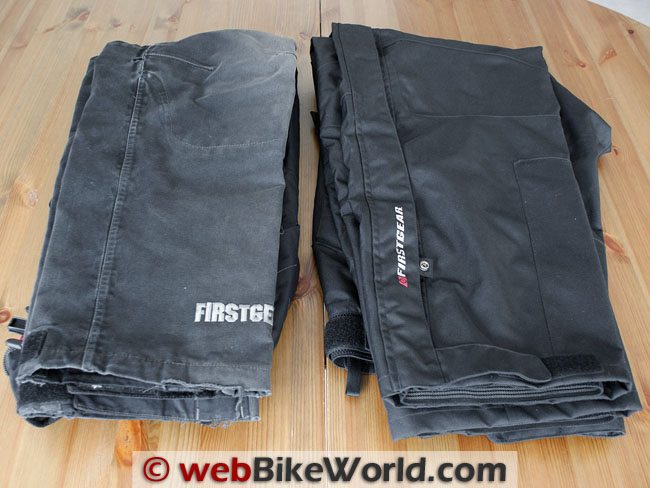
Comparing the Firstgear HT Overpants
While it would be very subjective to try and do a direct head-to-head between the well worn pair and the very new pair of HT Overpants, a few observations might help to identify both the positive and not so positive changes between the two sets.
Fitment
My pant sizing and comfort requirements have not changed through the years and Firstgear has maintained sizing for the HT products through the generations.
The old pants were full cut and comfortable, but I must admit that the new pants are better fitting in virtually every aspect.
Part of the redesign was to increase the inseam for Tall sizing slightly; my measurement comes out to 35 inches. But in any case, the new pants have about 1.5 inches of additional inseam over my old pants (appreciating some shrinkage).
This difference is noticeable both off and on the motorcycle.
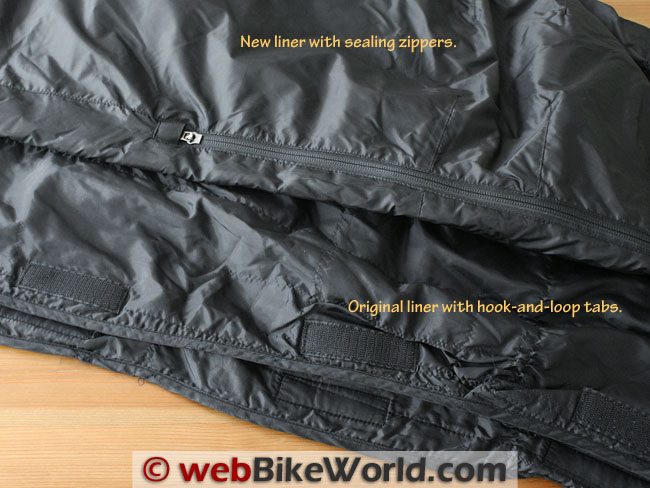
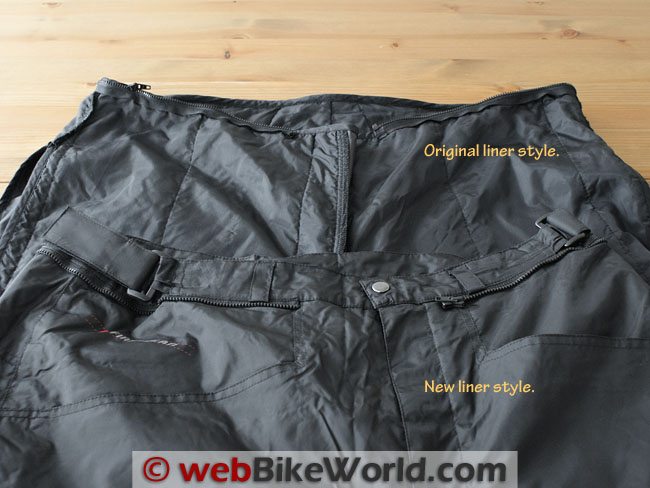
Riding Comfort
There’s a bit of surplus pant leg sitting on top of the boot when dismounted.
The situation changes completely when mounted and the new pants sit just where I want them to — on top of the foot portion of the boot, completely covering the lower leg and ankle.
The outer seam is 48.5 inches long and there is 13 inches of cut from the waist to the inseam.
This deep full cut makes the pants feel baggy off the motorcycle, but becomes multi-day long-distance comfortable when riding, particularly with the liners or another pair of pants worn underneath — remember, these are an overpant.
Waterproofing
The tried-and-true strong and weatherproof 600 denier Hypertex outer shell is still used for the outer shell (why change a proven thing?).
The shell material feels coarse, dense and just a bit stiff, but the material is actually very comfortable when worn.
On a related note, the discussion over the best materials to use for motorcycle clothing especially when addressing weatherproof and waterproof requirements is ongoing.
There are many debates that go on within industry and between motorcyclists regarding the best technology to use.
But based on my ownership of several Firstgear Kilimanjaro jackets, a Firstgear Jaunt Jacket (review) and now a third pair of the HT Overpants, my personal opinion is that Hypertex works as advertised in providing superb protection from the elements.
I have sustained multiple days of torrential rain while wearing a Firstgear jacket and the HT overpants and stayed absolutely dry and warm underneath.
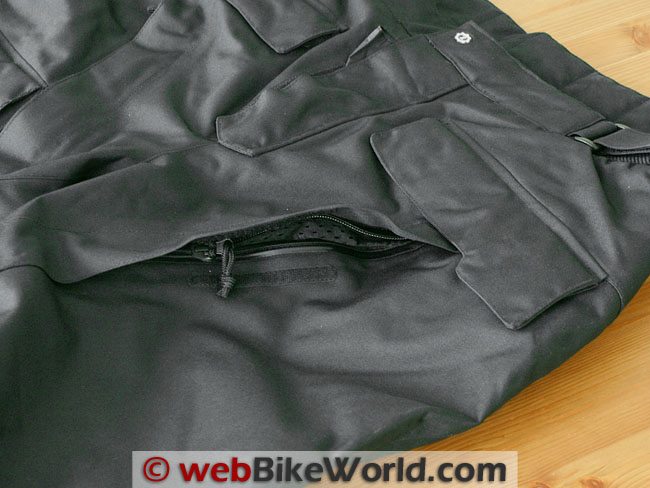
Zipper Issues
Zippers are a sensitive issue for me; I am very demanding regarding performance and durability and also very hard on them.
A poorly functioning or poorly stitched zipper gets few points from me and I have made some critical riding gear decisions based on this issue. But less two missing tabs, the much-used YKK zippers on the old pair function perfectly.
Unfortunately I cannot say the same for all the YKK zippers on the 2011 edition of the pants.
Although I miss the full length leg zipper found on the old pants, the heavy duty 2/3 length zippers on the new overpants work well, as does the fly zipper.
I could wish the rubberized (self-sealing) zippers used for the front vents worked as well. With the pants on, they are a pain to use and not just because they keep catching on the mesh liner stitched to the inner side of the pant leg.
I am hopeful that time and use will get them functioning a bit better.
The side, fly and waist zippers used on the inner liner pants are lightweight but all of them work fine, although it is necessary to apply some tension on the material most of the time to get them to run smoothly.
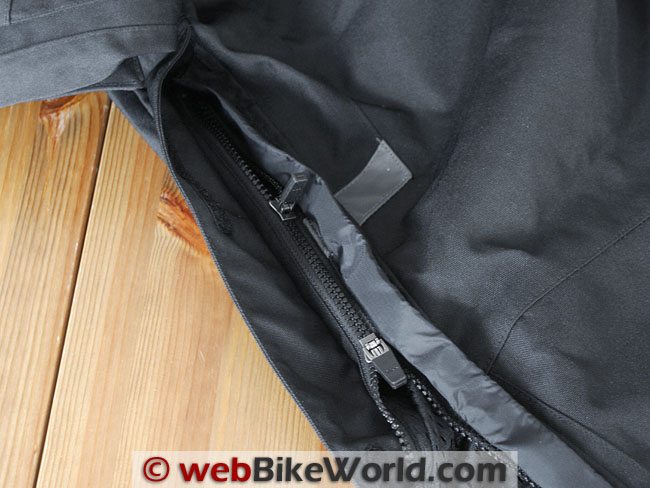
Storm Flaps
While speaking of things that seal or don’t, the largest not-so-positive issue I have with the new edition overpants are the storm flaps along the side of the leg that cover the full-length zippers.
These are also called side or gutter flaps.
The double-edge flap is still the same size as the old version of the HT Overpants and the older version features a continuous full-leg strip of hook-and-loop material.
Despite their age, the storm flaps on the original version still seal 100 percent.
The 2011 version of the HT Overpants do not use a continuous strip of hook-n-loop, but rather a series of four 10 cm long by 1 cm wide strips, which are spaced along the length of the zipper opening.
I suspect this approach is either a cost concession or a perception that the continuous strip was superfluous.
No matter the reason, I feel the logic is flawed, revealing a glaring deficiency that reduces overall performance of the pants.
Yes — on the original version, it takes more effort to make sure the double-edge flap is aligned correctly before affixing the two strips together. But once it’s done, nothing gets in.
If used as intended, for three-season riding (winter, spring and fall), it is important that the side flaps absolutely seal the outer edge of the pants to form an integral garment.
This keeps the elements out and prevents loss of body heat — primary objectives for heavy duty clothing.
Accordingly, the lighter-duty approach to sealing the storm flaps on the 2011 HT Overpants just doesn’t work as effectively.
This feature doesn’t totally fail the pants, but they sure don’t get an A+ like the old ones do in this regard.
With the flaps no longer held tightly in place all the way down the length of the zipper, and with the rider positioned on the motorcycle, gaps between the loop strips allow the flap to separate or lift.
This happens especially above and below the knee creating areas that the elements can exploit with resultant heat lost.
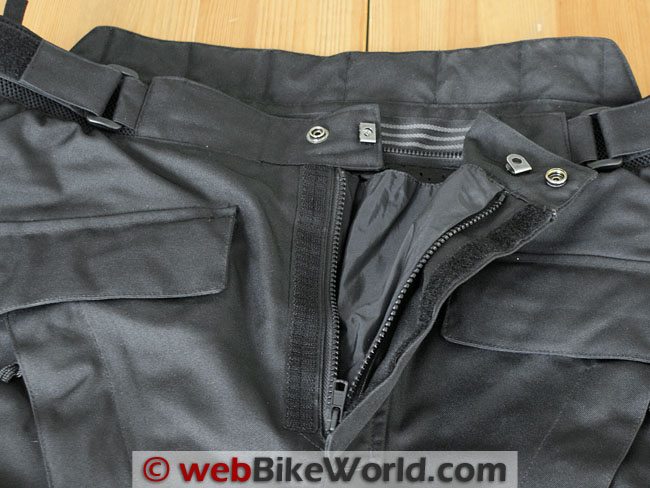
Firstgear HT Overpants Metal Fasteners
Another seemingly minor observation has to do with the snap waist fastener on the new pants.
The waist uses a double-closure system with two in-line fasteners, one a snap and the other a sliding hook, both metal.
On my pants, the snap fastener is weak and won’t stay together for more than a few seconds, with or without pressure on it. Thankfully the hook fastener engages positively and works well.
From a change perspective, the old Firstgear HT Overpants utilized a double-closure system as well as a heavy metal snap and large plastic buckle.
Both were strong and both continue to work without fail although the large plastic buckle can be intrusive at times.
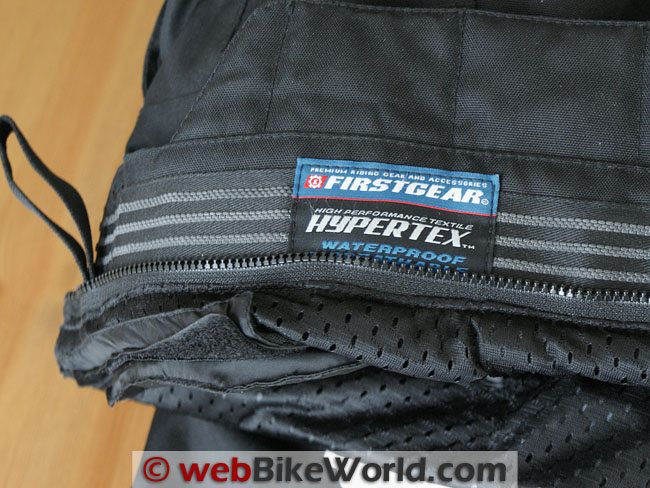
Seat-of-the-Pants Functionality
As mentioned earlier, getting a new pair of these treasured pants was great and despite the observations, they are still more than suitable for the tasks that I ask of them.
Florida was once again experiencing cold spells this December, déjà vu from last year, and the freeze line was creeping pretty far south.
So even though we consider ourselves to be hardy riders, the freezing nights and cool days dictated the use of full outerwear to remain comfortable.
Before getting the new 2011 Firstgear HT Overpants I usually wore my trusty, warm, and comfortable Olympia liner pants underneath the old HT Overpants and left the liners on when dismounted.
Similarly, I can now wear the HT inner pants and slip the overpants on before heading off on two wheels.
The side adjusters and useable belt loops on the liner pants that are part of the HT Overpants system provides a way to make immediate compression adjustments or to add a belt.
This is something the older Olympia liner pants didn’t handle as well. Both the inner liner and the outer HT Overpants shell feature a non-skid (silicone) strip at the waist to help prevent slippage.
The 2/3-length zippered openings still feel constrictive when stepping in and out of the HT Overpants, but that feeling is disappearing with use.
The two-way outer leg zippers run smoothly and the bottom over-flap makes sure the bottom end of the zipper is protected. I like two-way zippers for their versatility, especially when additional venting is needed.
For protection purposes, I usually wear the HT overpants year-’round, although a pair of the Firstgear HT Air Overpants (the warm-weather version of the HT Overpants) gets used on the really hot days.
Where the thinning material of the old HT Overpants actually worked to help cool things down on warmer days, the new version now sports slash-style front intake vents that seem to work well, even though their zippers are fussy.
The difference in protection from the elements is noticeable between the old and new versions of the HT Overpants.
I estimate that the old version has an efficiency rating of 60 to 75 percent when worn in the same conditions. Some days I was comfortable just wearing the new HT Overpants, whereas I would have needed the liner with the old pair.
Rain did make a few appreciated appearances during our trip and although direct exposure was limited, the 2011 Firstgear HT Overpants performed as expected, keeping me completely warm and dry.
I never head off without my two-piece BMW rain suit, but with the Firstgear kit on, the raingear seldom gets used for the wet stuff but instead to provide a wind-blocking layer and the risk of wind chill and heat loss can also be minimized by using a rain suit.
I may be overstating the storm flap issue, but when riding in conditions where the effects of wind chill are real and the need to retain body heat is critical, it should be considered.
I can think of a fix or two — like adding more fastener strips or going back to the original design with a continuous strip…
But having said this, for many riders and depending on the elements, the pants will work just fine. Further use of the new pants in cold and wet conditions over time should may prove or disprove my concern.
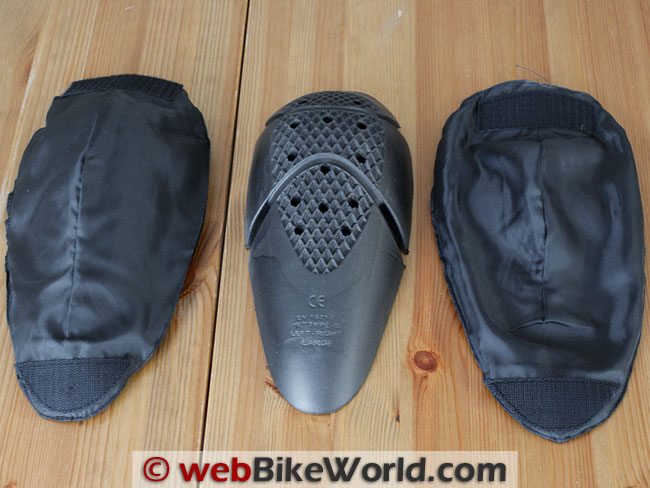
Conclusion
From a seat-of-the-pants perspective, so to speak, both the old and new versions of the Firstgear HT Overpants are nicely made and very functional.
Comfort with the HT Overpants is a given, but I have to give the nod here to the new version.
For protection from the elements, the original version of the HT Overpants — even thin and faded — still perform admirably. But using the new pants under the same conditions quickly reveals the reduced effectiveness of the old pants.
There are three main reasons for my continued relationship with Firstgear clothing: the first is off-the-shelf fit in my expected sizing; the second is quality and the third, performance.
Even after years of hard use the old HT Overpants remain as close to perfect as I could ever hope for and while there are flaws in the new pants, I won’t give them up — go figure.
So even though my immediate overpants requirement has been addressed, the larger issue of not being able to find suitable riding clothing in my size from other manufacturers remains.
This is the case not only for me, but for so many other riders. Some industry response to this problem would be appreciated.
Owner Comments and Feedback
See details on submitting comments.
From “W.J.” (02/11): “I put many thousands of miles on on a pair the older version of the HT Overpants.
The only improvement i would liked to have seen was better quality knee armor. I wish you had given more details on the armor, which appears to have been upgraded.”
HBC’s Reply: The armor now used on the HT Overpants and other items has been upgraded vis-à-vis the soft foam pads that were used on earlier versions for both the hip/kidney pads and the knee pads.
The shaped knee armor shown in the article photo is fully CE approved and a big advance over what you and I had in the earlier versions.
Depending on placement, it will cover from above to below the knee and if desired, third party armor could likely be used as there is room in the nylon enclosures and accessing the armor is easy.
The FirstGear website does provide some information on the armor used.



